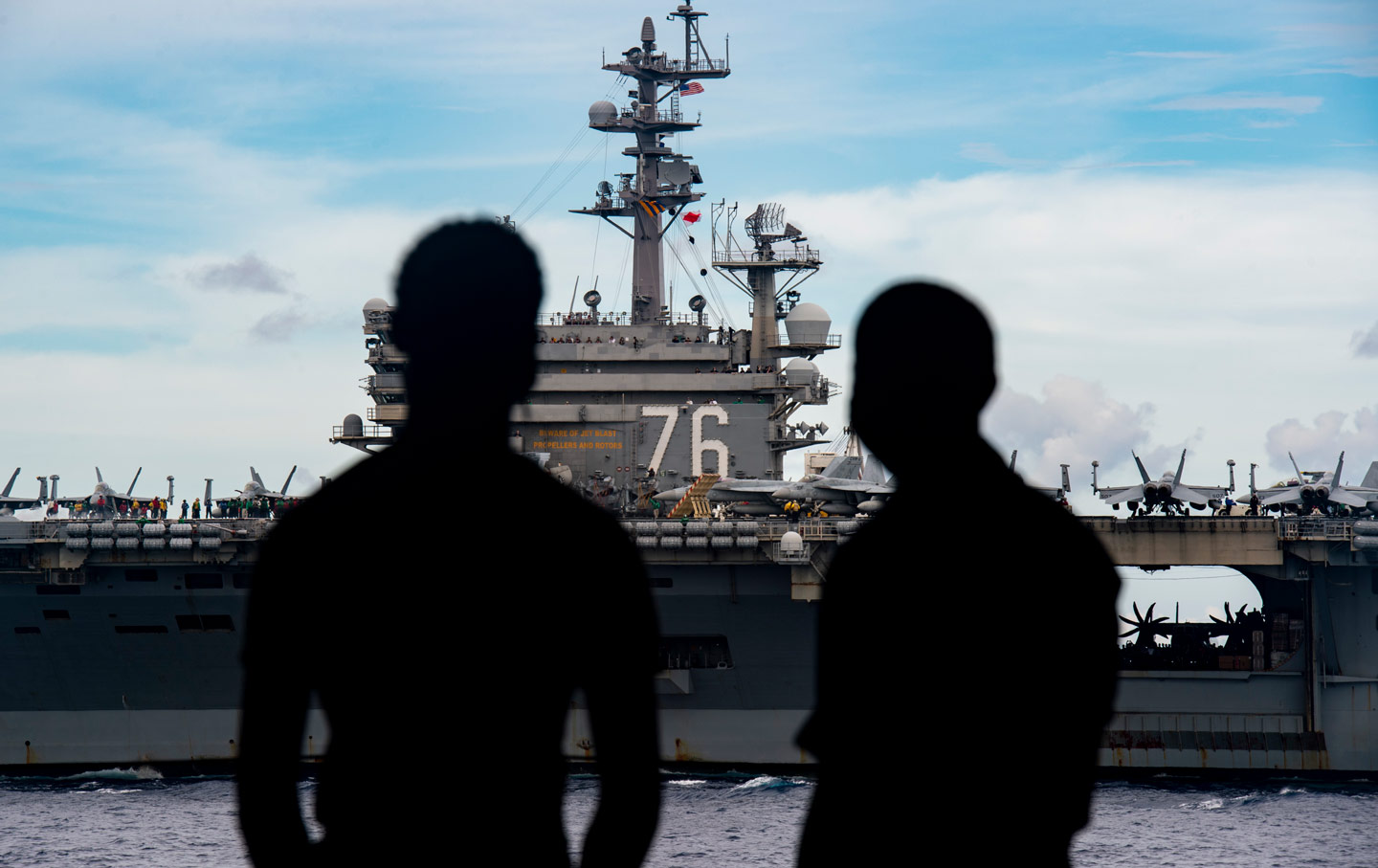Will the New Year Bring a War With China?
As the year comes to an end, top leaders in both Beijing and Washington have become ever more concerned that a major US-China crisis is near.

Sailors observe the USS Nimitz and USS Ronald Reagan Carrier Strike Groups steam in formation as the Nimitz Carrier Strike Force in the South China Sea.
(3rd Class Dalton Reidhead / Defense Department)This article originally appeared at TomDispatch.com. To stay on top of important articles like these, sign up to receive the latest updates from TomDispatch.com.
This hasn’t exactly been a year of good news when it comes to our war-torn, beleaguered planet, but on November 15, US President Joe Biden and Chinese President Xi Jinping took one small step back from the precipice. Until they talked in a mansion near San Francisco, it seemed as if their countries were locked in a downward spiral of taunts and provocations that might, many experts feared, result in a full-blown crisis, even a war—even, god save us all, the world’s first nuclear war. Thanks to that encounter, though, such dangers appear to have receded. Still, the looming question facing both countries is whether that retreat from disaster—what the Chinese are now calling the “San Francisco vision”—will last through 2024.
Prior to the summit, there seemed few discernible obstacles to some kind of trainwreck, whether a complete breakdown in relations, a disastrous trade war, or even a military clash over Taiwan or contested islands in the South China Sea. Beginning with last February’s Chinese balloon incident and continuing with a series of bitter trade disputes and recurring naval and air incidents over the summer and fall, events seemed to be leading with a certain grim inevitability toward some sort of catastrophe. After one such incident last spring, New York Times columnist Thomas Friedman warned that “the smallest misstep by either side could ignite a US-China war that would make Ukraine look like a neighborhood dust-up.”
In recent months, top leaders in both Beijing and Washington were becoming ever more concerned that a major US-China crisis—and certainly a war—would prove catastrophic for all involved. Even a major trade war, they understood, would create economic chaos on both sides of the Pacific. A complete breakdown in relations would undermine any efforts to come to grips with the climate crisis, prevent new pandemics, or disrupt illegal drug networks. And a war? Well, every authoritative nongovernmental simulation of a US-China conflict has ended in staggering losses for both sides, as well as a significant possibility of nuclear escalation (and there’s no reason to assume that simulations conducted by the American and Chinese militaries have turned out any differently).
As summer turned into fall, both sides were still searching for a mutually acceptable “offramp” from catastrophe. For months, top officials had been visiting each other’s capitals in a frantic effort to bring a growing sense of crisis under control. Secretary of State Antony Blinken traveled to Beijing in June (a trip rescheduled after he cancelled a February visit thanks to that balloon incident); Treasury Secretary Janet Yellen arrived in July; and Commerce Secretary Gina Raimondo in August. Similarly, Foreign Minister Wang Yi traveled to Washington in October. Their meetings, according to New York Times reporters Vivian Wang and David Pierson, were arranged “in the hope of arresting the downward spiral” in relations and to pave the way for a Biden-Xi meeting that might truly ease tensions.
Mission Accomplished?
Not surprisingly, for both Biden and Xi, the primary objective of the San Francisco summit was to halt that downward spiral. As Xi reportedly asked Biden, “Should [the United States and China] engage in mutually beneficial cooperation or antagonism and confrontation? This is a fundamental question on which disastrous mistakes must be avoided.”
From all accounts, it appears that the two presidents did at least stop the slide toward confrontation. While acknowledging that competition would continue unabated, both sides agreed to “manage” their differences in a “responsible” manner and avoid conflict-inducing behavior. While the United States and China “are in competition,” Biden reportedly told Xi, “the world expects the United States and China to manage competition responsibly to prevent it from veering into conflict, confrontation, or a new Cold War.” Xi reportedly endorsed this precept, saying that China would strive to manage its differences with Washington in a peaceful fashion.
In this spirit, Biden and Xi took several modest steps to improve relations and prevent incidents that might result in unintended conflict, including a Chinese promise to cooperate with the United States in combating the trade in the narcotic drug fentanyl and the resumption of high-level military-to-military communications. In a notable first, the two also “affirmed the need to address the risks of advanced [artificial intelligence] systems and improve AI safety through US-China government talks.” They also put their stamp of approval on a series of cooperative steps agreed to by their climate envoys John Kerry and Xie Zhenhua to mutually combat climate change.
Still, neither president agreed to any fundamental alterations in policy that might have truly shifted bilateral relations in a more cooperative direction. In fact, on the most crucial issues dividing the two countries—Taiwan, trade, and technology transfers—they made no progress. As Xue Gong, a China scholar at the Carnegie Endowment for International Peace, put it, whatever the two presidents did accomplish, “the Biden-Xi meeting will not change the direction of US-China relations away from strategic competition.”
With that still the defining constant in relations and both leaders under immense pressure from domestic constituencies—the military, ultra-nationalist political factions, and assorted industry groups—to hang tough on key bilateral issues, don’t be surprised if the slide towards crisis and confrontation regains momentum in 2024.
The Trials to Come
Assuming US and Chinese leaders remain committed to a nonconfrontational stance, they will face powerful forces driving them ever closer to the abyss, including both seemingly intractable issues that divide their countries and deeply entrenched domestic interests intent on provoking a confrontation.
Although several highly contentious issues have the potential to ignite a crisis in 2024, the two with the greatest potential to provoke disaster are Taiwan and territorial disputes in the South China Sea.
A self-governing island that increasingly seeks to pursue its own destiny, Taiwan is viewed by Chinese officials as a renegade province that should rightfully fall under Beijing’s control. When the United States established formal diplomatic relations with the People’s Republic of China (PRC) in 1979, it acknowledged the Chinese position “that there is one China and Taiwan is part of China.” That “one China” principle has remained Washington’s official policy ever since, but is now under increasing pressure as ever more Taiwanese seek to abandon their ties with the PRC and establish a purely sovereign state—a step that Chinese leaders have repeatedly warned could result in a military response. Many American officials believe that Beijing would indeed launch an invasion of the island should the Taiwanese declare their independence and that, in turn, could easily result in US military intervention and a full-scale war.
For now, the Biden administration’s response to a possible Chinese invasion is governed by a principle of “strategic ambiguity” under which military intervention is implied but not guaranteed. According to the Taiwan Relations Act of 1979, any attempt by China to seize Taiwan by military means will be considered a matter “of grave concern to the United States,” but not one automatically requiring a military response. In recent years, however, increasing numbers of prominent Washington politicians have called for the replacement of “strategic ambiguity” with a doctrine of “strategic clarity,” which would include an unequivocal pledge to defend Taiwan in case of an invasion. President Biden has lent credence to this stance by repeatedly claiming that it is US policy (it isn’t), obliging his aides to eternally walk back his words.
Of course, the question of how China and the United States would respond to a Taiwanese declaration of independence has yet to be put to the test. The island’s current leadership, drawn from the pro-independence Democratic Progressive Party (DPP), has so far accepted that, given the way Taiwan is slowly achieving de facto independence through diplomatic outreach and economic prowess, there’s no need to rush a formal declaration. But presidential elections in Taiwan this coming January and the possible emergence of another DPP-dominated administration could, some believe, trigger just such a move—or, in anticipation of it, a Chinese invasion.
Popular
“swipe left below to view more authors”Swipe →Should the DPP candidate William Lai win on January 13th, the Biden administration might come under enormous pressure from Republicans—and many Democrats—to accelerate the already rapid pace of arms deliveries to the island. That would, of course, be viewed by Beijing as tacit American support for an accelerated drive toward independence and (presumably) increase its inclination to invade. In other words, Joe Biden could face a major military crisis remarkably early in 2024.
The South China Sea dispute could produce a similar crisis in short order. That fracas stems from the fact that Beijing has declared sovereignty over nearly the entire South China Sea—an extension of the western Pacific bounded by China, Taiwan, the Philippines, Borneo, and Vietnam—along with the islands found within it. Such claims have been challenged by that sea’s other bordering states, which argue that, under international law (notably the U.N. Convention on the Law of the Sea) they are entitled to sovereignty over the islands that fall within their individual “exclusive economic zones” (EEZs). In 2016, the Permanent Court of Arbitration in the Hague ruled on a petition from the Philippines that China’s claims were invalid and that the Philippines and its neighbors were indeed entitled to control their respective EEZs. China promptly both protested the ruling and announced its intention to disregard it.
Chinese control over those islands and their surrounding waters would have significant economic and strategic implications. To begin with, it extends China’s defense perimeter several hundred miles from its coastline, complicating any future US plans to attack the mainland while making a PRC assault on US and allied bases in the region far easier. The South China Sea also harbors major fisheries, an important source of sustenance for China and its neighbors, as well as vast reserves of oil and natural gas coveted by all the states in the region. China has consistently sought to monopolize those resources.
To facilitate its control over the area, the PRC has established military installations on many of the islands, while using its coast guard and maritime militias to drive off the fishing boats and oil-drilling vessels of other states, even ramming some of those ships. On October 22nd, for example, a large Chinese coast guard vessel bumped into a smaller Philippine one seeking to reinforce a small outpost of Philippines Marines located on the Second Thomas Shoal, an islet claimed by both countries.
In reaction to such moves, officials in Washington have repeatedly asserted that the United States will assist allies affected by Chinese “bullying.” As Secretary of Defense Lloyd Austin declared in July at a meeting with Australian officials in Brisbane, “We’ll continue to support our allies and partners as they defend themselves from bullying behavior.” Three months later, following that clash at the Second Thomas Shoal, Washington reaffirmed its obligation to defend the Philippines under the 1951 Mutual Defense Treaty, should Filipino forces, ships, or aircraft come under armed attack, including “those of its coast guard—anywhere in the South China Sea.”
In other words, a future clash between Chinese vessels and those of one of Washington’s treaty partners or close allies could easily escalate into a major confrontation. Just what form that might take or where it might lead is, of course, impossible to say. But it’s worth noting that, in recent South China Sea exercises, the US Indo-Pacific Command has conducted large-scale combat drills, involving multiple aircraft carriers, cruisers, destroyers, and submarines. Any US military response on such a scale would undoubtedly prompt a comparable Chinese reaction, setting in motion a potential spiral of escalation. Assuming that China continues its policy of harassing the fishing and exploration activities of its southern neighbors, a clash of this sort could occur at almost any time.
Resisting Bellicose Impulses
Given the dangers in Taiwan and the South China Sea, Presidents Biden and Xi will have to exercise extreme patience and prudence to prevent the ignition of a full-blown crisis in 2024. Hopefully, the understanding they developed in San Francisco, along with new crisis-management tools like enhanced military-to-military communications, will help them manage any problems that do arise. In doing so, however, they will have to overcome both the escalatory dynamics built into those disputes and bellicose domestic pressures from powerful political and industrial factions that view intense military competition with the other side (if not necessarily war) as attractive and necessary.
In both the United States and China, vast military-industrial operations have blossomed, fed by mammoth government disbursements intended to bolster their ability to defeat the other’s military in all-out, high-tech combat. In this hothouse environment, military bureaucracies and arms-makers on each side have come to assume that perpetuating an environment of mutual suspicion and hostility could prove advantageous, leaving key politicians ever more obliged to shower them with money and power. On December 13th and 14th, for example, the US Senate and House, seemingly incapable of passing anything else, approved a record defense policy bill that authorized $886 billion in military spending in 2024 ($28 billion more than in 2023), with most of the increase earmarked for ships, planes, and missiles intended primarily for a possible future war with China. American military leaders—and politicians representing districts with a high concentration of defense contractors—are sure to request even greater spending increases in future years to overcome “the China threat.”
A similar dynamic fuels the funding efforts of top Chinese military-industrial officials, who no doubt are citing evidence of Washington’s drive to overpower China to demand a reciprocal buildup, including (all too ominously) of their country’s nuclear forces. In addition, in both countries, various political and media figures continue to benefit by harping on the “China threat” or the “America threat,” adding to the pressure on top officials to take strong action in response to any perceived provocation by the other side.
That being the case, Presidents Biden and Xi are likely to face a series of demanding challenges in 2024 from the seemingly intractable disputes between their two nations. Under the best of circumstances, perhaps they’ll be able to avoid a major blow-up, while making progress on less contentious issues like climate change and drug trafficking. To do so, however, they’ll have to resist powerful forces of entrenched bellicosity. If they can’t, the fierce wars in Ukraine and Gaza in 2023 could end up looking like relatively minor events as the two great powers face off against each other in a conflict that could all too literally take this planet to hell and back.
More from The Nation

The Fall of Syria Changes Everything The Fall of Syria Changes Everything
Retired diplomat Chas Freeman and writer Pascal Lottaz discuss what happens now that Damascus is in the hands of Hayat Tahrir al-Sham.

Netanyahu Must Be Brought to Justice. But We Can’t Stop There. Netanyahu Must Be Brought to Justice. But We Can’t Stop There.
This genocide is a massive criminal undertaking, and we must hold as many of its perpetrators accountable as we can.

My Brother Chef Mahmoud Almadhoun Died Because He Fed Gaza’s Starving Citizens My Brother Chef Mahmoud Almadhoun Died Because He Fed Gaza’s Starving Citizens
His killing by Israel sent a chilling message that no one is safe, including humanitarians who stand in the way of Gaza’s erasure.

The Underground Network Helping Gazan Refugees Survive in Egypt The Underground Network Helping Gazan Refugees Survive in Egypt
A patchwork of volunteer-run mutual aid organizations has sprung up to tackle the severe problems facing people fleeing genocide.

The Dangers of Trump’s Foreign Policy The Dangers of Trump’s Foreign Policy
Strategic incoherence and factionalism reign.

Macronism Has Died a Second Death Macronism Has Died a Second Death
The French parliament votes to oust the government.


